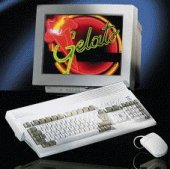










© 1997-2006
Gareth Knight
All Rights reserved

|
|

Amiga Set-top boxes
The Amiga has had a long and turbulent history as a set-top
machine, yet the Classic Amiga OS remains perfectly suited to the
role; it can be used with a TV, can surf the internet, and can be
used as a full computer. Despite many efforts to develop a machine
to fulfill this role, few have suceeded in actually bringing it to
market. This page provides a complete list of the numerous attempts
to develop for the market.
Amiga CD32

Both Sony and Sega have promoted the notion of a console that can
be turned into a full computer, send email, etc. Many seem to
forget that such a thing was possible back in 1993. The combination
of the CD32 and SX-1/SX32 expansion can turn the game console into
a fully-fledged Amiga, allowing the user to surf the internet or
write a letter on their TV. When Escom bought the Amiga in 1995
they announced that the CD32 would be tailored to fill this market.
Visit the CD32 or SX32 page
| Developer |
Escom/third part developers |
| Year of (predicted) Release |
The SX-/SX32 expansion modules have been available since
1995. |
Hombre Console
It is known that at the time of the Commodore liquidation they were
developing a 4th generation chipset called Hombre. One of the
planned systems for this technology was a low-end CD32 unit. If the
machine had actually been developed it is likely that it would have
also provided basic internet access and additional features to turn
it into a full computer.
| Developer |
Commodore |
| Year of (predicted) Release |
1995 - 1996 |
Amiga Surfer

The Amiga Surfer was a half-baked idea to sell the Amiga to the
set-top market. It consisted of a basic A1200 bundled with a 28k
modem and software to surf the internet. Read
more.
| Developer |
Amiga Technologies |
| Year of Release |
1996 |
Viscorp ED

The Amiga ED (Electronic Device) was a set-top box developed by
Viscorp for the low-end internet market. It would have provided
basic internet services such as e-mail, web browsing, online
gaming, and banking. Once the device had been completed it would
have been licensed to third party manufacturers. Read more.
| Developer |
Viscorp |
| Year of (predicted) Release |
1996 |
M-Box
A news article in an Amiga magazine indicated that Micronik were
developing an Amiga set-top. The project was never heard from
again. Read more.
| Developer |
Micronik |
| Year of (predicted) Release |
1999 |
Amiga MCC

A low-end consumer system developed by Gateway for the Convergence
market. The project was eventually cancelled to concentrate on a
purely software solution. The MCC lives on under the title of AOL
TV. Read more.
| Developer |
Amiga Inc/Gateway |
| Year of (predicted) Release |
2000 |
BACK |
|
|

|
Latest updates to the Amiga History Guide. (more)
|


Other interesting items in the archive!
|
|













